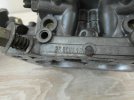JTBernhardt
True Classic
I'm looking at buying a set of 36 DCNF carburetors for my '75 X1/9. I had originally planned on going with 40's, but I'm of the thinking that without more modifications and a compression bump the 36's will be a better compromise. The engine is running a stock 1500cc engine with a slightly ported and polished head with an Alquati A16 camshaft and an ANSA 4-2-1 header and dual tip muffler.
So my question about the 36DCNF's I've found is pertaining to ported vacuum. The set I found appear to have extra vacuum ports and I'm curious as to whether these would allow for the stock Bosch electronic ignition set ups vacuum advance to work properly? Pictures below. Notice there is a single port on the rear of the carbs and dual ports at the front base of each carb.


So my question about the 36DCNF's I've found is pertaining to ported vacuum. The set I found appear to have extra vacuum ports and I'm curious as to whether these would allow for the stock Bosch electronic ignition set ups vacuum advance to work properly? Pictures below. Notice there is a single port on the rear of the carbs and dual ports at the front base of each carb.

